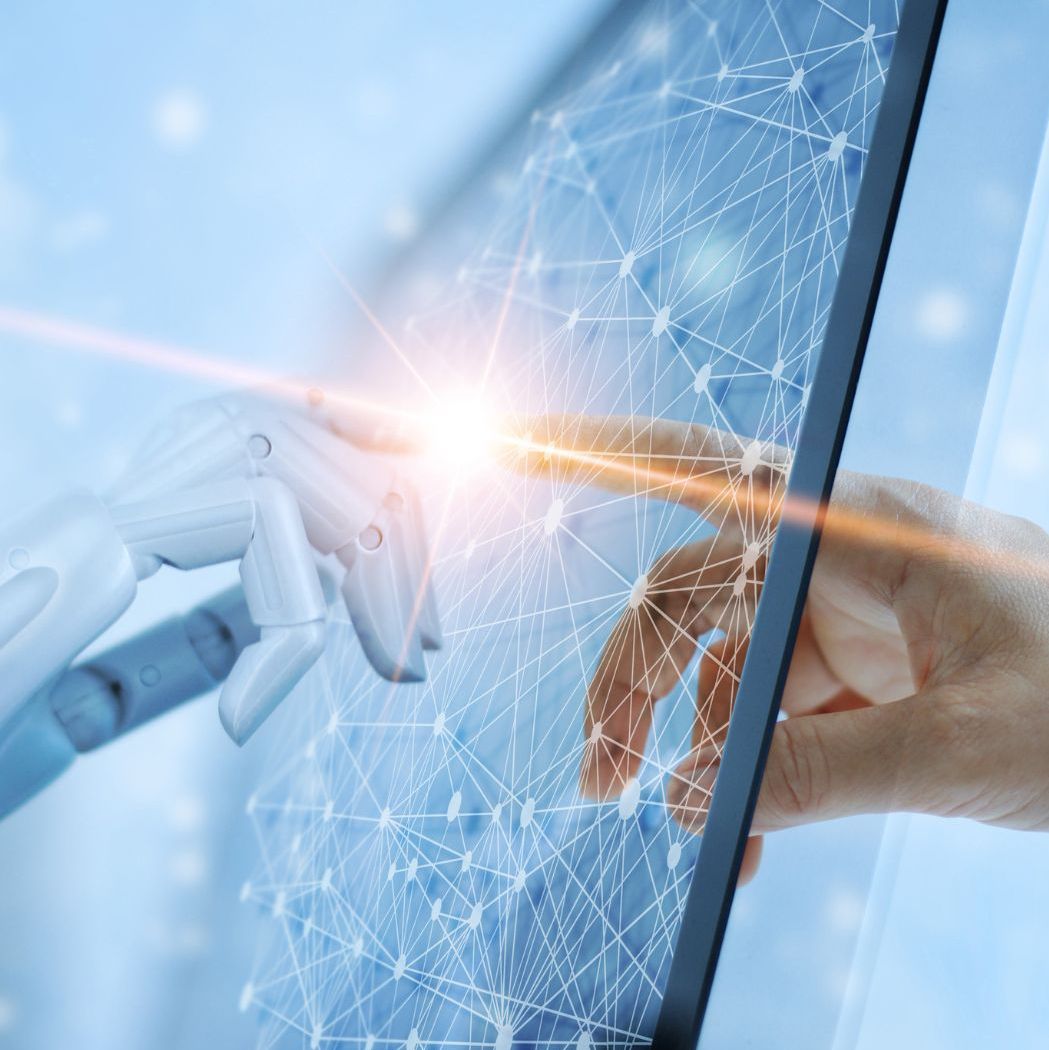AI vs. Human Transcription Services:
A Comparative Analysis
As the demand for transcription services skyrockets, fuelled by the explosion of digital content and data-driven strategies, understanding the nuances between AI transcription and human transcription becomes pivotal. This short guide centres on how these services compare and which might best serve your needs in various professional contexts.
Here are three common questions we often encounter when it comes to human vs automatic transcription:
- What are the accuracy rates between AI and human transcription services?
- How do AI transcription services adapt to different accents and dialects?
- What is the cost-effectiveness of automated vs human transcription services?
The transcription industry has witnessed transformative changes with the advent of AI technologies, pushing the boundaries of what automated systems can achieve. However, despite significant advancements, the debate between automated vs human transcription remains vibrant, reflecting varying needs across tech-savvy industries. This article delves into a comparative analysis of AI transcription and human transcription services, offering insights into their respective advantages, applications, and future potential.
Human vs AI Transcription Comparison: 10 Key Differences (2024)
#1 Technological Foundations of AI Transcription
AI transcription leverages sophisticated algorithms, machine learning models, and extensive data sets to convert speech into text. This technology continues to evolve, enhancing its ability to understand context, manage different accents, and reduce errors over time. However, the complexity of language with its nuances often poses a challenge that AI is still grappling with.
AI transcription technologies harness complex algorithms, including machine learning and deep learning models, to convert spoken language into written text with increasing proficiency. These systems are trained on vast datasets containing diverse language samples, which allow them to improve over time through techniques such as neural network training and natural language processing. AI’s ability to learn and adapt has enabled it to make significant strides in recognising speech with varying accents and in noisy environments, which historically have been challenging.

Despite these advancements, AI transcription still struggles with the subtleties of human language, such as detecting sarcasm, interpreting mixed languages, and understanding context-dependent meanings, which can dramatically affect the accuracy of the transcription.
The development of AI transcription also focuses on improving error correction algorithms to minimise inaccuracies in the output. These improvements are crucial for applications where precision is key, such as in legal depositions or medical transcriptions. However, the technology’s reliance on predefined data and algorithms can lead to errors when encountering unfamiliar accents or terminologies not included in its training set.
#2 The Human Touch in Transcription
Human transcriptionists bring a personal touch to the transcription process, capable of understanding cultural idioms, industry-specific terminology, and non-standard speech patterns. Their ability to interpret context and apply critical thinking ensures higher accuracy, particularly in complex scenarios such as legal proceedings, medical records, or highly technical discussions.
Human transcriptionists play an irreplaceable role in maintaining high-quality transcription standards, particularly in scenarios requiring a deep understanding of the context, specialised terminology, and nuanced language. Unlike their AI counterparts, human transcribers can interpret subtle cues such as tone, emotional inflection, and implicit meanings, which are often lost in automated transcription.
This capability is particularly critical in fields like law and medicine, where a misinterpreted word could alter the meaning of a text significantly. Human transcriptionists also excel in adapting to various dialects and non-standard speech without prior training, unlike AI systems that require extensive datasets to handle new accents or dialects effectively.
Furthermore, human transcription services are able to offer bespoke solutions tailored to specific client needs, such as verbatim transcription, time-stamping, and formatting according to precise specifications. This level of customisation and the ability to interact directly with clients to clarify ambiguities in the speech adds a layer of quality control that AI currently cannot match. As the transcription industry evolves, the value of human insight remains high, ensuring that transcripts are not only accurate in word but also in intended meaning, especially in complex, high-stakes environments.
#3 Accuracy and Reliability
When comparing AI transcription to human transcription, accuracy often tops the list of considerations. While AI can deliver fast and reasonably accurate transcripts, its performance may degrade with poor audio quality or diverse accents. Human transcriptionists excel in ensuring high fidelity to the original speech, particularly in specialised fields.
Accuracy is the cornerstone of any transcription service, and here, the distinction between AI and human transcription becomes particularly prominent. AI transcription tools offer impressive speed and can produce transcripts with a reasonable level of accuracy under optimal conditions. However, their performance is notably affected by factors such as background noise, overlapping speech, and varying audio quality.
In contrast, human transcriptionists are capable of understanding complex audio dynamics and can deliver high-quality transcripts even when audio conditions are less than ideal. Their ability to ask for clarifications or review unclear passages allows for a level of reliability that automated systems cannot yet achieve.
The reliability of transcription services also extends to the fidelity of the transcript to the original recording. While AI can quickly transcribe large volumes of speech, it may miss subtle nuances or misinterpret words with multiple meanings based on the context. Human transcribers, skilled in linguistic nuances and contextual interpretation, provide an indispensable layer of accuracy that is crucial for transcripts used in legal proceedings, academic research, and high-level business meetings. As technology advances, the gap may narrow, but for now, human transcription remains the more reliable method, especially in specialised and context-heavy settings.
#4 Cost Implications
AI transcription services generally offer a more cost-effective solution for bulk and less nuanced transcription needs. They provide rapid turnaround times at lower costs, making them ideal for straightforward projects. In contrast, human transcription services are more costly but are indispensable for detailed and high-quality requirements.
AI transcription services are generally more cost-effective than human transcription, particularly for straightforward, bulk transcription tasks. The ability of AI to process large amounts of audio quickly without fatigue reduces labor costs and allows for pricing that is often more attractive to clients with large-scale transcription needs. This cost advantage makes AI transcription an appealing option for projects where speed and budget are prioritised over absolute accuracy, such as drafting content for webinars or generating searchable text from long video content.
However, when it comes to high-stakes environments where precision is paramount, the cost of human transcription is justified by its higher accuracy and lower risk of error. Human transcriptionists not only provide accurate transcriptions but also offer additional services such as proofreading, editing, and quality assurance checks, which are crucial for documents that must adhere to strict regulatory standards or legal requirements. In these cases, the investment in human transcription ensures that the final product meets the necessary quality standards, often making it more cost-effective in terms of reducing the risk of costly errors or misunderstandings that could arise from inaccurate transcriptions.
#5 Speed and Scalability
AI transcription services shine in their ability to handle large volumes of audio quickly, making them suitable for real-time applications such as live broadcasts or quick turnarounds on large projects. Human transcription, while slower, is more scalable in terms of quality control and customisation for specific project needs.
AI transcription services excel in their ability to handle vast quantities of audio data quickly, making them ideal for scenarios where time is of the essence. The scalability of AI systems allows for simultaneous transcription of multiple streams of audio, a capability unmatched by human transcriptionists. This rapid processing power makes AI transcription particularly effective for live events, broadcasts, and other applications requiring real-time or near-real-time transcription. Additionally, the integration of AI transcription into various software and platforms can further streamline workflows, enabling automatic transcription of phone calls, meetings, and media content without human intervention.
Despite these advantages, human transcription services are preferred when the scalability of quality is a concern. Human transcriptionists can scale their accuracy and attention to detail based on the complexity of the audio and the specific requirements of the project. This means they can adjust their transcription techniques and focus on delivering high-quality results for complex content such as multi-speaker seminars, detailed technical discussions, and legal documents.
Moreover, human transcription services can be customised to include additional layers of quality control, such as multiple rounds of proofreading and editing by separate individuals, which enhances the reliability and accuracy of the transcripts.

#6 Handling of Complex Terminologies
In environments like medical or legal fields, where the accuracy of each term can be critical, human transcriptionists provide an indispensable level of precision. AI, while improving, often struggles with jargon and specialised vocabularies unless specifically trained on them.
In specialised fields such as medicine, law, and technical sciences, the accurate transcription of complex terminologies is critical. Human transcriptionists have a significant advantage in this area due to their ability to research and apply specific domain knowledge. This expertise enables them to accurately transcribe specialised terms and industry-specific jargon that AI transcription systems might misinterpret or miss altogether. Human transcribers often have backgrounds or training in specific fields, allowing them to understand the context and significance of the terminology used, thereby reducing errors and improving the quality of the transcription.
AI transcription, while continually improving through advances in machine learning and natural language processing, still faces challenges with specialised vocabularies. Although it can be trained on specific datasets to recognise and accurately transcribe domain-specific language, this often requires extensive and ongoing training data to maintain accuracy. Furthermore, AI systems may struggle with new or evolving terminologies not yet included in their training sets. The dynamic nature of language in specialised fields necessitates a flexible and adaptive approach that human transcriptionists are better equipped to handle.
#7 Privacy and Security
The issue of privacy and security is crucial, especially with sensitive information. Human transcription services can offer more controlled environments and are often bound by strict confidentiality agreements. AI services, while secure, depend heavily on the technological measures in place to protect data integrity and confidentiality.
The confidentiality and security of information are paramount in transcription services, especially when handling sensitive data. Human transcription services often operate within stringent security protocols, including non-disclosure agreements and secure data handling practices. These measures ensure that all transcribed materials remain confidential and are only accessible to authorised personnel. Human transcriptionists can also work in controlled environments that further minimise the risk of data breaches or unauthorised access.
On the other hand, AI transcription services must rely on robust digital security measures to protect the data they process. While these services offer the advantage of reducing human interaction with sensitive data, thereby potentially lowering the risk of intentional data leaks, they are not immune to cybersecurity threats. The storage and processing of data on servers, especially in cloud-based environments, require advanced security protocols to safeguard against hacking and unauthorised access. As technology evolves, the security of AI transcription services continues to improve, but maintaining trust and ensuring compliance with privacy regulations remain ongoing challenges.
#8 Customisation and Flexibility
Human transcription services offer greater flexibility in terms of formatting, speaker identification, and adherence to specific guidelines. AI transcription services are getting better at customisation but still lag behind the bespoke nature of human-driven outputs.
Customisation is a critical feature of transcription services that caters to the specific needs of users. Human transcription services offer superior flexibility in terms of document formatting, speaker identification, and adherence to specific transcription guidelines that may vary from one project to another. This ability to tailor services to exact specifications is particularly valuable in legal, academic, and professional settings where document format and detail accuracy are crucial. Human transcribers can also interact directly with clients to clarify ambiguities or confirm specific preferences, enhancing the overall quality of the final transcript.
While AI transcription services are becoming more adaptable and starting to offer more customisation options, they generally lack the human ability to understand and implement complex formatting or nuanced client-specific requirements fully. However, AI technology is progressing, and some services now include features such as custom vocabularies and adjustable settings for timestamps and speaker labels. As AI continues to integrate deeper learning and contextual understanding, the gap in customisation and flexibility between human and automated transcription services is expected to narrow, potentially offering the best of both speed and personalisation in the future.
#9 Integration with Other Technologies
AI transcription services can be seamlessly integrated with other AI-driven technologies, providing a comprehensive ecosystem for speech analysis, data extraction, and even predictive analytics. This integration offers significant advantages in tech-savvy industries aiming for extensive digital transformation.
AI transcription services are not just standalone tools; they represent a crucial part of a larger ecosystem of AI-driven applications. Their ability to integrate seamlessly with other technologies allows for the creation of a comprehensive digital workflow that can include speech recognition, predictive text analytics, and even automated content generation. This level of integration is highly advantageous for tech-savvy industries that are pushing the boundaries of digital transformation. For instance, in customer service, AI transcription can be directly linked to CRM systems to automate the logging of conversations and assist in data analysis, leading to more informed business decisions and improved customer relations.
Moreover, the integration capabilities of AI transcription extend to real-time applications such as subtitle generation for live broadcasts or instant translation services, which are essential in today’s globalised communication environment. The ability to connect with other AI modules allows for a multifunctional platform that can learn from diverse data inputs and improve over time, thereby enhancing the accuracy and utility of the transcription service. As AI continues to evolve, these integrative features are expected to become even more sophisticated, offering unprecedented scalability and flexibility in how transcription services are deployed and utilized across different sectors.
#10 Future Prospects and Innovations
The future of transcription services will likely see a hybrid model where AI and human efforts are combined to leverage the strengths of both. Innovations in AI are continuously reducing the gap in accuracy and adaptability, while human expertise is evolving to handle more strategic aspects of transcription and analysis.
The transcription industry is poised at the brink of a new era, with advancements in AI transcription promising to bridge the gap between automated efficiency and human accuracy. The future likely holds a hybrid model where AI and human transcriptionists work in concert to provide a balanced service that maximises both speed and precision.
Innovations in AI, such as improved machine learning models and better context understanding, are expected to continually enhance the capability of transcription services to handle complex and nuanced audio in a variety of settings. These advancements will not only improve the performance of AI in challenging transcription scenarios but also reduce the workload on human transcriptionists, allowing them to focus on quality control and nuanced editing tasks.

Furthermore, ongoing research into neural networks and artificial intelligence could lead to breakthroughs that enable AI transcription to understand and process human language as naturally as a human listener. With these innovations, the transcription industry could see a significant shift in how services are structured and delivered, offering more customised, secure, and efficient solutions to meet the diverse needs of users.
The integration of AI with other cognitive technologies like sentiment analysis and behavioural prediction could also open new avenues for automated services that extend far beyond simple transcription, providing enriched data that could transform industries such as market research, healthcare, and legal services.
Key Tips When Choosing AI Auto or Human Transcription
- Consider the specific needs of your project: accuracy, speed, or cost before choosing between AI and human transcription.
- Evaluate the confidentiality requirements of your information to decide on the most secure option.
- Stay informed about the latest developments in transcription technologies to make educated decisions.
- Think about the potential need for integration with other digital tools and platforms.
- Regularly reassess your choice of transcription services as new improvements and features are continually being developed.
Feature Human Transcription Service
This comparative analysis highlights that both AI and human transcription services offer unique benefits. At Way With Words, we provide an advanced and customised set of transcription and speech-to-text solutions to ensure highly accurate transcripts. Our service includes human checks for any automated transcripts and full human-only transcription services upon request, ensuring that all transcripts meet high-quality standards and are GDPR and fully data compliant.
Choosing between AI and human transcription services depends largely on your specific needs and the nature of the content. While AI transcription is fast and cost-effective, human transcription remains superior in terms of accuracy, privacy, and customisation. As we look to the future, the transcription industry will likely innovate towards a blend of both, maximising efficiency and quality.
Human Transcription Services Resources
Way With Words: Your ultimate solution for all your transcription and speech-to-text needs and custom requirements.
Wikipedia: Transcription software.
